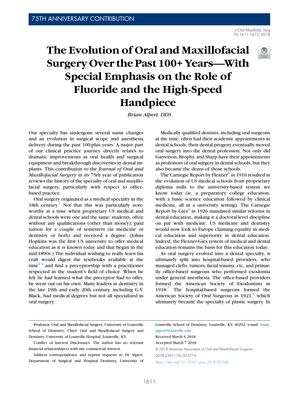The Evolution of Oral and Maxillofacial Surgery Over the Past 100 Years: Emphasis on Fluoride and High-Speed Handpiece
July 2018
in “
Journal of Oral and Maxillofacial Surgery
”

TLDR Oral and maxillofacial surgery has advanced with fluoride reducing tooth decay and high-speed handpieces aiding in more aesthetic procedures, leading to changes in practice and training.
Over the last 100 years, oral and maxillofacial surgery has significantly evolved, with the introduction of fluoride in the 1960s leading to a decrease in tooth decay and a shift in focus from decay treatment to prevention and aesthetics. This change resulted in fewer extractions of non-restorable teeth and more removals of impacted third molars, facilitated by the high-speed handpiece. The field split into hospital-based and office-based practices, with the latter becoming lucrative due to the emphasis on exodontia under general anesthesia. Training programs adapted to new anesthesia techniques, and the rise of managed care in the past 25 years has seen a decline in hospital-based practices, with complex surgeries being left to subspecialists. Meanwhile, the increase in dental implant surgeries has advanced the sophistication of office-based practices. Despite these shifts, oral and maxillofacial surgery remains financially successful and highly regarded due to its expertise in pain and anxiety control and efficient office practices.




